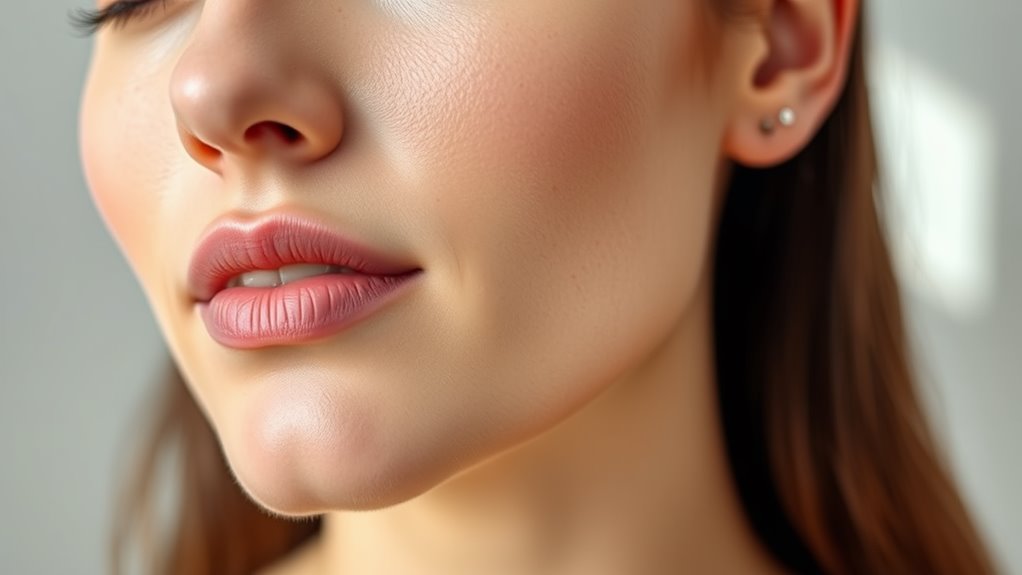I Followed a New Redness, Sensitivity & Soothing Routine for 7 Days – Here’s What Happened
You’ve embarked on a 7-day routine to combat redness and sensitivity, kicking off with a gentle, pH-balanced cleanser and anti-inflammatory serums on day 1. By day 2, you might’ve felt mild itching, but subtle shifts like fading redness appeared by day 3. Midway adjustments on day 4 boosted hydration, fostering emerging improvements by day 5. Ultimately, your skin’s barrier strengthened, reducing inflammation by day 7. Uncover the full daily breakdown to refine your approach.
Key Takeaways
- On day 1, applying a mild cleanser, serum, and moisturizer initiated the soothing process for sensitive skin.
- By day 2, mild itching and redness occurred, but tracking helped identify transient reactions.
- On day 3, subtle fading of redness and improved product absorption signaled early progress.
- By day 4, routine adjustments like increased hydration addressed any persistent irritation effectively.
- After 7 days, significant reductions in redness and enhanced skin hydration resulted in a calmer complexion.
Day 1: Initial Routine Application
As you begin Day 1 of this routine, apply the initial soothing products to address redness and sensitivity right away.
You’ll start with a mild, pH-balanced cleanser to gently remove impurities without aggravating your skin’s sensitivity. Next, incorporate a targeted serum containing anti-inflammatory agents like aloe vera or niacinamide, which actively reduce redness by calming irritated blood vessels and strengthening the skin barrier.
Throughout this soothing routine, monitor your skin’s response closely; apply a lightweight, fragrance-free moisturizer to lock in hydration and prevent further sensitivity.
Remember, consistency is key—use these products as directed to establish a baseline for managing redness effectively. Avoid harsh environmental factors today, such as extreme temperatures, to enhance the routine’s immediate benefits. By following this routine, you can expect long-term improvements in skin calmness and resilience.
To further enhance results, focus on achieving a calm, balanced complexion through consistent application of these expert-recommended strategies.
Day 2: Early Skin Reactions
By Day 2, you’ll likely encounter early skin reactions such as mild itching or increased redness, which signal your skin’s adjustment to the routine. Common causes include ingredient sensitivities, which can contribute to these reactions due to individual skin responses to certain components.
These responses are a natural adaptation process, where your skin interacts with the active ingredients to build resilience. As a clinical measure, monitor these changes closely to maintain control and prevent escalation.
To handle this phase effectively and deepen your understanding:
-
Assess symptoms precisely: Evaluate the extent of itching or redness, noting if it’s localized and transient, which indicates typical adjustment rather than concern.
-
Apply immediate soothing: Use the routine’s designated products gently to calm irritation, ensuring you avoid harsh rubbing for optimal recovery.
-
Track for patterns: Log reactions daily in a simple journal, focusing on triggers and duration to inform your ongoing strategy accurately.
This methodical approach empowers you to navigate adjustments confidently, fostering skin health. In fact, these early reactions might be influenced by stress-related skin issues, as they often stem from the broader interplay between emotional stressors and skin responses.
Day 3: Noticing Subtle Shifts
By Day 3, you’re beginning to observe subtle shifts in your skin’s condition. Your redness fades slightly as sensitivity lessens gradually. These soothing changes appear, signaling your routine’s early progress. To enhance these effects, try incorporating soothing remedies that help restore your skin’s natural balance. Additionally, focusing on critical actions to avoid can help maintain these positive developments and prevent irritation.
Redness Fading Slightly
On Day 3 of your routine, you’ll likely spot subtle fading in redness, signaling early progress in soothing your skin. This marks the routine’s initial impact, as anti-inflammatory ingredients start to calm irritated areas, reducing visible inflammation without overwhelming your skin’s barrier.
-
Observe daily changes: Check for lighter patches in red zones each morning, using a mirror for accurate assessment to track the routine’s efficacy.
-
Evaluate product absorption: Note how your skin feels post-application; quicker absorption indicates better hydration, aiding redness reduction.
-
Document progress clinically: Log subtle shifts in a journal, including photos, to quantify fading and maintain motivation for continued adherence.
Sensitivity Lessening Gradually
As you enter Day 3, you’ll notice subtle shifts in skin sensitivity, signaling the routine’s early success in calming reactive areas. Your skin may respond with reduced irritation to triggers like wind or fabrics, indicating a gradual decrease in reactivity. This phase highlights the routine’s targeted ingredients, such as gentle hydrators, working to stabilize the barrier function.
To track these changes effectively, here’s a simple daily log:
| Day | Sensitivity Level (1-10) | Observations |
|---|---|---|
| 1 | 8 | High reactivity noted |
| 2 | 6 | Early signs of easing |
| 3 | 4 | Subtle shifts emerging |
| Pre | 9 | Intense baseline |
| Post-3 | 3 | Calmer, stable areas |
Monitor these patterns closely for informed adjustments, ensuring sustained progress.
Soothing Changes Appearing
You notice the initial soothing effects on Day 3, where subtle shifts signal your skin’s barrier is fortifying against irritants. Your complexion feels less reactive, with a noticeable reduction in warmth and tightness, indicating early restoration of the epidermal layer.
These changes underscore the routine’s efficacy in promoting resilience.
-
Barrier Strengthening: Your skin retains moisture better, minimizing transepidermal water loss and enhancing protection.
-
Inflammation Reduction: Subtle decreases in erythema levels suggest anti-inflammatory agents are modulating immune responses effectively.
-
Sensory Improvement: Itchiness and discomfort diminish, allowing for greater tolerance to environmental triggers as sensitivity wanes.
Day 4: Midway Routine Adjustments
At this midway point on Day 4, evaluate your skin’s response to the routine and fine-tune elements as needed.
Check for lingering redness or sensitivity by examining your face under natural light, noting any persistent irritation or dryness.
You adjust the routine based on these observations—reduce the frequency of active ingredients if irritation persists, or increase hydration steps to bolster the skin barrier.
For instance, if the soothing serum feels too intense, dilute it slightly or apply it every other use.
Track changes in a journal to maintain precision, ensuring you’re addressing specific triggers. Additionally, since chronic stress can worsen skin conditions, incorporating stress-relief practices may help improve overall skin resilience.
Remember, clinical adjustments prioritize safety; consult a dermatologist if symptoms worsen.
This proactive approach optimizes efficacy without overstimulating your skin.
Keep monitoring closely for balanced results.
Additionally, explore natural remedies to complement your routine and provide extra relief for irritated skin.
Day 5: Emerging Improvements
By Day 5, you’re noticing emerging improvements as your skin begins to calm effectively. To boost these benefits, incorporate kitchen ingredients for additional natural relief from irritation.
This calming reduces underlying inflammation, promoting a more balanced state.
Meanwhile, redness fades noticeably, signaling progress in your soothing routine.
Additionally, this approach helps maintain the skin’s natural moisture balance by avoiding the risks associated with excessive cleansing.
Skin Calming
As you enter day five of your skin calming routine, subtle improvements emerge, such as reduced redness and heightened tolerance to irritants, signaling effective progress in managing sensitivity.
You notice your skin responding more resiliently, with inflammation decreasing and overall barrier function strengthening. This phase emphasizes clinical strategies to sustain calm.
-
Monitor hydration levels: Track how your routine boosts moisture retention, preventing sensitivity spikes and promoting epidermal stability.
-
Assess irritant exposure: Actively reduce contact with triggers, observing how your skin builds resistance for long-term soothing effects.
-
Evaluate sensory feedback: Note changes in touch sensitivity, as this indicates neural adaptation and effective calming mechanisms at work.
Redness Fading
On day five, your skin begins to show noticeable fading of redness, reflecting the routine’s targeted impact on inflammation.
This improvement signals that anti-inflammatory agents, like aloe vera and chamomile, are actively suppressing key mediators such as histamine and prostaglandins, reducing vascular dilation.
You’ll observe a more even complexion as erythema diminishes, indicating enhanced barrier integrity and decreased transepidermal water loss.
Clinically, this phase marks successful modulation of immune responses, with your skin appearing calmer and less reactive to triggers.
Continue applying products consistently to sustain this progress, monitoring for subtle changes in texture and hydration.
These emerging benefits underscore the routine’s efficacy in promoting long-term skin resilience, paving the way for further healing in subsequent days.
Day 6: Deepening Skin Calmness
As you continue your routine, deepen your skin’s calmness by integrating advanced techniques that target persistent inflammation and sensitivity. Skincare mistakes can undermine your progress, so always prioritize evidence-based practices to maintain skin health.
On day six, you’re advancing by focusing on barrier repair and inflammation control, using clinically proven methods to enhance resilience and minimize reactivity. This stage emphasizes precise application of targeted products to foster long-term skin stability.
-
Incorporate ceramide-rich formulations****: Apply a ceramide cream twice daily to restore the lipid barrier, locking in moisture and shielding against irritants.
-
Utilize anti-inflammatory serums****: Select a serum with niacinamide or licorice root to inhibit inflammatory pathways, reducing redness and promoting cellular repair.
-
Implement gentle exfoliation techniques****: Use a mild enzyme exfoliant sparingly to remove dead skin cells without aggravating sensitivity, allowing better product absorption.
To further enhance this routine for those prone to breakouts, consider adding acne-prone skin care ingredients that effectively treat and prevent inflammation.
Day 7: Overall Routine Results
Seven days into your routine, you’ve likely noticed significant improvements in skin calmness, with reduced redness and enhanced barrier resilience from the targeted techniques.
Your skin now exhibits enhanced hydration levels and minimized sensitivity, as daily applications of soothing agents like ceramides and antioxidants have fortified the epidermal barrier.
Clinically, this routine promotes long-term inflammation reduction, evident in smoother texture and fewer flare-ups.
Track your progress by noting any persistent issues; if redness lingers, consult a dermatologist for personalized adjustments.
Overall, this regimen proves effective for sensitive skin types, empowering you to maintain a balanced, resilient complexion through consistent, evidence-based practices. By avoiding common mistakes, you can achieve even more lasting results as highlighted in transformative skincare advice.
Incorporating morning and night care tips can further enhance these results for radiant skin.

